How To Use Castor Oil For Hair Growth, Benefits, & Side Effects
Bid farewell to various hair issues with this incredibly moisturizing oil!
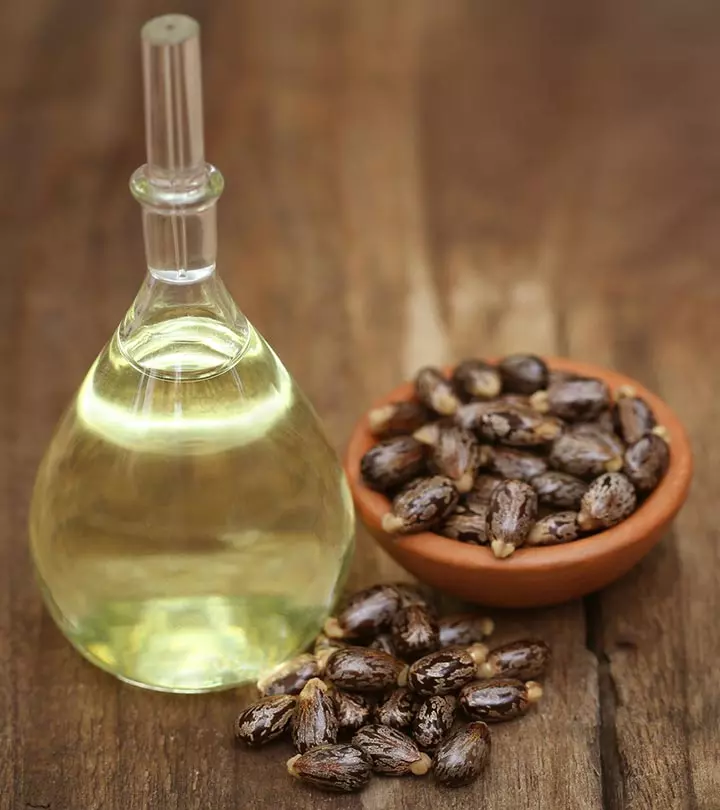
Image: Shutterstock
Many people use castor oil for hair growth. It is widely used to manage hair fall, combat hair damage, and improve hair health. When used regularly, it can add shine to your hair. Anecdotally evidence claims that it is one of the best natural remedies to improve hair growth, combat dandruff, moisturize hair, and manage infections of the scalp.
Read on to learn more about why you should include castor oil in your hair care regimen, castor oil benefits for hair, and how to use it to reap the benefits it offers.
 Know Your Ingredient: Castor Oil
Know Your Ingredient: Castor OilWhat Is It?
A yellowish oil extracted from castor beans.
What Are Its Benefits?
Castor oil nourishes hair follicles, boosts hair growth and luster, and maintains scalp health.
Who Can Use It?
Anyone with dry scalp or hair fall issues may use the oil.
How Often?
It can be used 2-3 times a week.
Caution
People allergic to castor oil and with pre-existing skin conditions (like dermatitis) should avoid using it.
In This Article
How Does Castor Oil Work?
This vegetable oil is cold-pressed and extracted from castor beans. It is a pale yellow, viscous, and non-volatile oil that has been used for ages. It is also a prevalent beauty staple for hair growth and scalp treatment that works without stripping off the natural hair moisture.
But is castor oil good for hair? The unique structure of castor oil with a fatty acid profile makes it a perfect humectant to seal moisture, provide nourishment to the hair shaft, and promote hair growth.
Here’s why you can choose castor oil for hair growth.
Why Choose Castor Oil For Hair Growth
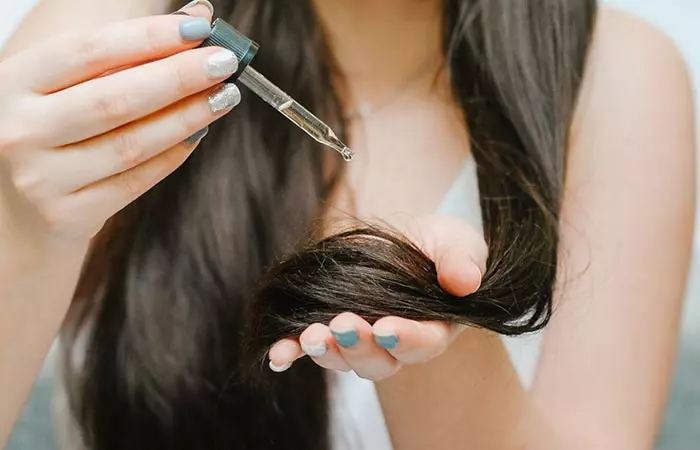
- Castor oil, when combined with other carrier oils, stimulates hair growth due to the presence of vitamin E and fatty acids. It stimulates blood circulation and strengthens the hair roots (1).
- Ricinoleic acid, one of the major constituents of castor oil, has anti-inflammatory properties (2). Hence, it may help reduce scalp inflammation.
- The antibacterial, antifungal, and antioxidant properties of castor oil may help treat hair loss (3). The oil could also prevent scalp infections.
- Castor oil contains the highest percentage of fatty acids (long-chain carbonic acids (99%), like omega-6 fatty acids) compared to any other carrier oil (4). A study showed that omega-6 fatty acids (arachidonic acid) promote hair growth by increasing the growth factors in human dermal papilla cells (cells that promote dermal-epidermal reactions to regulate the hair growth cycle) (5).
- Castor oil may improve the appearance of hair and increase its luster (6).
Audrey Victoria, a Youtuber, shared her experience of using castor oil for hair growth for 30 days. She said, “After using castor oil before a shower I have found that when I do use castor oil my hair comes out looking like this. It just looks really healthy and smooth and silky. The days that I don’t use castor oil my hair looks a lot drier (i)”.
- On average, hair follicles grow about 0.5 to 1.7 cm per month. But certain anecdotal studies showed that castor oil (thanks to its strong fatty acid content, including 90% ricinoleic acid) stimulates prostaglandin E2 (active lipid compound) that activates the dilation of blood vessels to improve blood flow. Better blood flow supplies more oxygen and nutrients to the dermal papilla, or the hair roots, leading to healthier hair growth and improved hair nourishment.
- Castor oil also contains antioxidants that protect hair from environmental aggressors and strengthen the hair roots (3).
- A study showed that castor oil, when diluted with other carrier oils, helps reduce split ends, hair loss, and hair damage (7).
In the next section, we have discussed how to use castor oil effectively for hair growth. Keep reading.
How To Use Castor Oil For Hair Growth
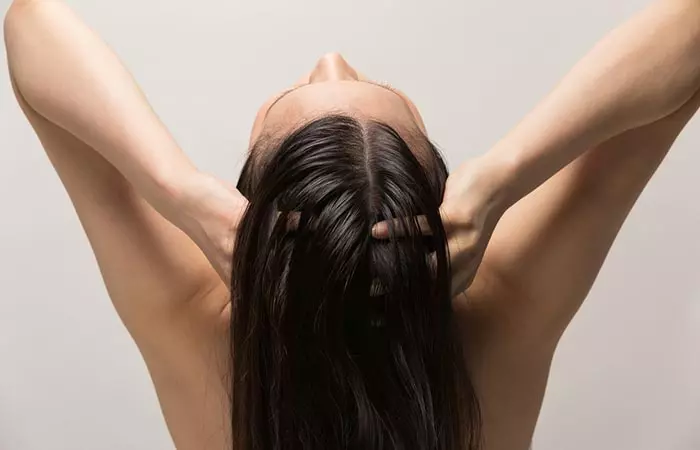
Castor oil can be used in various ways to promote hair growth. But do you know how to apply castor oil on hair? While some massage it on the scalp and leave it on for 2-3 hours before washing it away, others leave the oil on overnight. You can choose the method that is comfortable for you. Check the following recipes for the effective application of castor oil for hair loss prevention and promoting hair regrowth.
 Quick Tip
Quick Tip1. How To Use Castor Oil To Combat Hair Loss
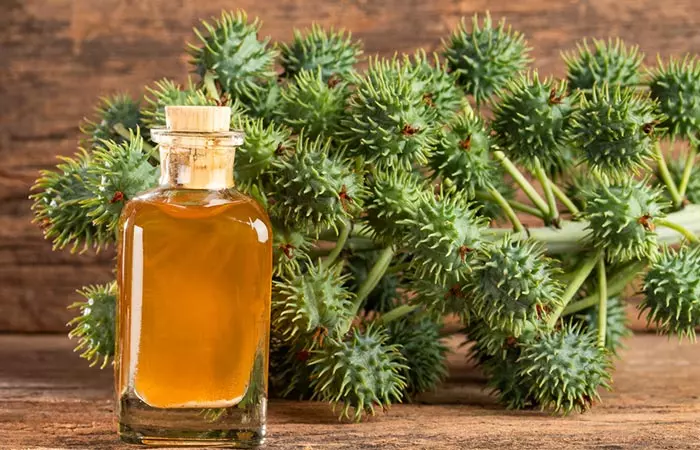
What You Need
- 1/2 cup castor oil
Directions
- Take some castor oil in your palm and work it through your hair from the root to the tip (the same way you apply regular oil). Massage well. Castor oil has a thicker density and could be difficult to be washed out. Hence, make sure you do not use too much oil.
- Leave the oil in for a minimum of 15-20 minutes. You could also leave it on overnight.
- You will need to shampoo multiple times to get rid of the oil. You may also condition your hair with a commercial conditioner 30 minutes before you take a shower.
- Once you wash your hair, gently towel dry it. Avoid using any heat styling tools immediately.
While your hair may feel moisturized, it will take a while before you see significant results.
Note: This treatment works best on slightly damp hair.
2. How To Use Castor Oil For Hair Regrowth
Some anecdotal evidence suggests that castor can help treat hair loss and even stimulate hair regrowth. Since it is thick and heavy, you can pair it up with another oil to dilute it. Castor oil also has a peculiar smell that may not go well with everyone. Pairing it with other oils, like almond oil, can help solve this issue.
The following potion is a combination of four oils – coconut, sweet almond, sesame, and castor. While you can add or remove oils depending on availability and preference, using all four oils together can give you the most effective results.
What You Need
- 2 tablespoons of extra virgin coconut oil
- 2 tablespoons of sweet almond oil
- 2 tablespoons of sesame oil
- 1 tablespoon of castor oil
Directions
- Mix the four oils and massage the mixture into your scalp, from the root to the tip. You could slightly warm the oil mixture for quicker penetration.
- Keep the mixture on for about 60 minutes. You could also leave it on overnight.
- Shampoo your hair and wash the oil mixture off.
This oil mixture could help induce hair growth. You can make it in large quantities and store. Adding a vitamin E capsule to the mixture can increase its shelf life.
 Quick Tip
Quick TipYou can also make certain DIY hair masks with castor oil to moisturize, nourish, and revive your locks. Listed below are some of the homemade recipes with castor oil that help in hair growth and hair strengthening.
DIY Hair Masks With Castor Oil For Hair Growth
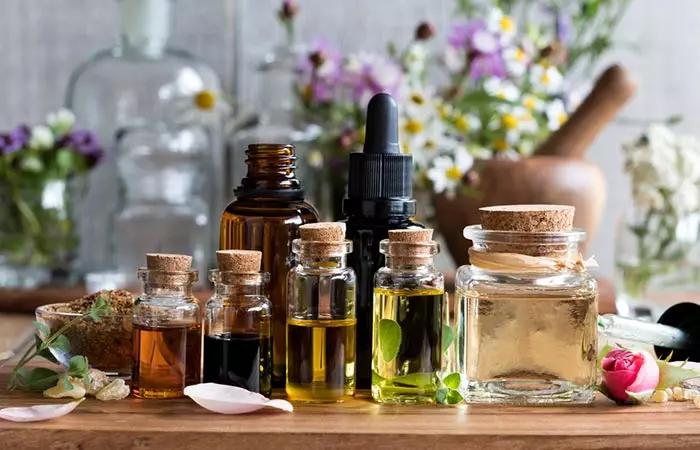
1. Castor Oil And Olive Oil Mix For Hair
What You Need
- 1-2 tablespoons of castor oil
- 1-2 tablespoons of olive oil
- 5-6 hibiscus petals
What You Need To Do
- Mix equal proportions of the two oils in a small cup.
- Add hibiscus petals to the oil mixture.
- Heat the oil mixture on a medium flame for 10 seconds and apply it to your hair.
- Massage your scalp gently for 10-15 minutes.
- Wrap your head with a steamed towel to seal the moisture.
- Leave it on for an hour. Wash it off with lukewarm water and shampoo.
- Repeat this process weekly for the best results.
How It Helps In Hair Growth
Olive oil contains a high proportion of mono- and poly-unsaturated fatty acids that may protect the hair moisture barrier and seal the moisture. Its other compounds also work as moisturizing agents (8). It also helps condition your hair and reduce hair loss (7). In a study on telogenic mouse skin, topical administration of 0.4 mg olive oil resulted in anagenic hair growth (an active growth phase of hair follicles) (9).
Note: You can also use a blend of castor, olive, and lavender oils.
2. Castor Oil And Coconut Oil Mix For Hair
What You Need
- 2 tablespoons of castor oil
- 2 tablespoons of coconut oil (liquid)
What You Need To Do
- Mix castor oil and coconut oil in a bowl and apply gently to dry hair.
- Massage your scalp well for at least five minutes.
- Spread the oil mix thoroughly into your hair and put on a shower cap.
- Keep the hair mask on for at least two hours before washing it off. You may also leave it on overnight.
- Follow this treatment twice a week for two to three months to regain hair at a faster pace.
How It Helps In Hair Growth
Coconut oil contains both medium and long-chain fatty acids that strengthen hair and help prevent hair damage (10). The oil penetrates the hair cuticlesi The outermost layer of the hair shaft that forms from the accumulation of dead cells and protects the hair from damage. and hair cortexi The middle layer of the hair shaft between the hair cuticle and the medulla that provides the hair with its pigment. , providing deep nourishment to the hair strands. It safeguards against the damaging effects of chemical hair treatments (11). Coconut oil also reduces protein loss from chemically-treated and untreated hair (12).
3. Aloe Vera And Castor Oil For Hair Growth
What You Need
- 2 teaspoons of castor oil
- 1/2 cup of aloe vera gel
- 1 teaspoon of basil powder
- 2 teaspoons of fenugreek powder
What You Need To Do
- Use a hand blender to blend all the ingredients and form a thick hair mask.
- Apply this paste to your hair and scalp gently, ensuring you have covered every hair strand.
- Wear a shower cap and let the mask set deeply into your hair. Leave it on for two to three hours.
- Rinse it off by using a mild shampoo and lukewarm water.
How It Helps In Hair Growth
Aloe vera strips off the excess oil, dirt, and impurities from the scalp. It is rich in vitamins A, C, and E. Vitamin E contributes to rapid cell turnover, reduces oxidative stress in the scalp, and decreases hair loss (13).
In a study in The International Journal of Scientific Research in Science and Technology, the topical application of fenugreek seed gel could improve hair growth on Wistar albino rats (14).
Note: Use this blend of castor oil and aloe vera to relieve itchy scalp, dandruff, and hair loss.
4. Castor Oil And Peppermint Oil For Hair Growth
What You Need
- 100 ml of castor oil
- 2-3 drops of peppermint oil
What You Need To Do
- Add two to three drops of peppermint oil to the castor oil and shake well.
- Part your hair in the middle and apply the mixture directly to your scalp.
- Repeat this process until your whole head is covered.
- Let the mask stay on for at least two hours before washing it off.
- You can use this blend twice a week for a couple of months to witness faster results.
How It Helps In Hair Growth
The topical application of peppermint oil was found to induce hair growth in four weeks. It could stimulate the anagen stage (the period when new hair is formed) of hair growth (15). It also could maintain the anagen phase for a longer time and reduce hair loss. It could further help increase hair thickness, follicle numbers, and follicle depth.
The methanol in peppermint oil promotes hair growth. In a study in the Microvascular Research, the topical application of methanol was found to promote blood flow (16). This phenomenon could help boost hair growth.
5. Castor Oil And Almond Oil Mix For Hair Growth
What You Need
- 2 tablespoons of castor oil
- 2 tablespoons of almond oil
What You Need To Do
- Mix the oils in a bowl and heat the mixture on a medium flame for a few seconds.
- Apply this blend to your scalp and hair.
- Massage well for 5-10 minutes using your fingers.
- Wash it off with lukewarm water and a mild shampoo.
How It Helps In Hair Growth
Almond oil contains 68% of oleic acid and 25% of linoleic acid (17). These could improve hair resilience and act as a protective barrier in moisture control. A study on rats showed that almond oil could potentially promote hair growth (18).
6. Onion Juice And Castor Oil For Hair Growth
What You Need
- 2 tablespoons of castor oil
- 2 tablespoons of onion juice
What You Need To Do
- Add two tablespoons of onion juice in a bowl containing two tablespoons of castor oil. Blend.
- Massage your scalp and hair gently with this mix.
- Leave it on for about two hours.
- Rinse the oil off gently by using a mild shampoo and lukewarm water.
How It Helps In Hair Growth
A clinical trial showed that about 87% of people treated with crude onion juice demonstrated fuller hair regrowth (19). Moreover, the nutrients in the onion juice may improve hair shine and strength.
7. Castor Oil And Avocado Oil For Hair Growth
What You Need
- 1 tablespoon of castor oil
- 1 tablespoon of avocado oil
- 1 tablespoon of olive oil
What You Need To Do
- Mix the three oils in a bowl.
- Apply the mixture to your scalp and massage gently for 5-10 minutes with your fingertips.
- Wash it off after two to three.
- Use this oil once every week for stronger, healthier hair.
How It Helps In Hair Growth
Avocado seed oil is a rich source of essential fatty acids like linoleic acid and linolenic acids (20). These may maintain hair resilience and shine.
8. Castor Oil And Rosemary Oil For Hair Growth
What You Need
- 2 teaspoons of castor oil
- 2 teaspoons of coconut oil
- 2-3 drops of rosemary essential oil
What You Need To Do
- Mix castor oil and coconut oil in a bowl. Heat the container until they are blended.
- Add a few drops of rosemary essential oil to this blend.
- Massage your scalp and hair with this hot oil mixture for 5-10 minutes. This hot oil treatment allows nutrients to seep into the hair follicles and seals hair shine.
- Leave the oil on for another 15 minutes.
- Use a mild shampoo to wash your hair.
- Follow this treatment every week for a few months for the desired results.
How It Helps In Hair Growth
A study showed that rosemary oil helps treat androgenic alopecia (hormonal hair loss) and promotes effective hair growth (21). Moreover, rosemary oil contains antioxidant and antimicrobial properties that protect the hair strands from environmental damage and prevent fungal infections. The oil may also increase hair count (22).
There are primarily three types of castor oils available on the market. Let us take a quick look at them.
Types Of Castor Oils
- Organic/Cold-Pressed Castor Oil: Organic/cold-pressed castor oil is extracted directly from the castor seeds without heating.
- Jamaican Black Castor Oil (JBCO): Jamaican black castor oil is prepared by roasting and crushing the castor seeds in a mortar. Water is added to this powder, and the whole mixture is slow-boiled over a fire.
- Hydrogenated Castor Oil (Castor Wax): It is produced by the hydrogenation (a chemical reaction processed in the presence of a catalyst) of pure castor oil, often in the presence of a nickel catalyst.
Which of these three varieties is preferable? We will understand the same in the following section.
What Is The Best Type Of Castor Oil For Hair Growth
The health benefits of the cold-pressed castor oil and JBCO are similar, except that the Jamaican variant has more pronounced benefits, given its unadulterated processing method.
Anecdotal research suggests that Jamaican black castor oil improves blood circulation to the scalp, thereby encouraging hair thickening and growth. The oil may also nourish the scalp, strengthen the hair roots, and treat thinning hair. It could make your hair thicker, fuller, and shinier as well.
Cold-pressed castor oil mainly works on the hair shaft and leaves luminous, shiny hair. Moreover, JBCO has a thicker consistency and suits even those with thicker or coarse hair. While the cold-pressed castor oil has a slightly thinner consistency, it best suits those with thin or fine hair.
How Often Should You Use Castor Oil On Your Hair?
Oiling your hair helps keep it hydrated and nourished. You need to oil your hair at least once or twice a week. Keep in mind that too much castor may cause hair feltingi A condition in which the hair becomes severely tangled due to lack of combing or care and starts to resemble a solid mass. (23). Hence, you can try a combination of castor oil with other oils like jojoba, coconut, or olive.
Castor oil is thick and sticky. Hence, washing it off your hair could be a strenuous task. The following section helps you overcome this.
How To Remove Castor Oil From Hair Easily
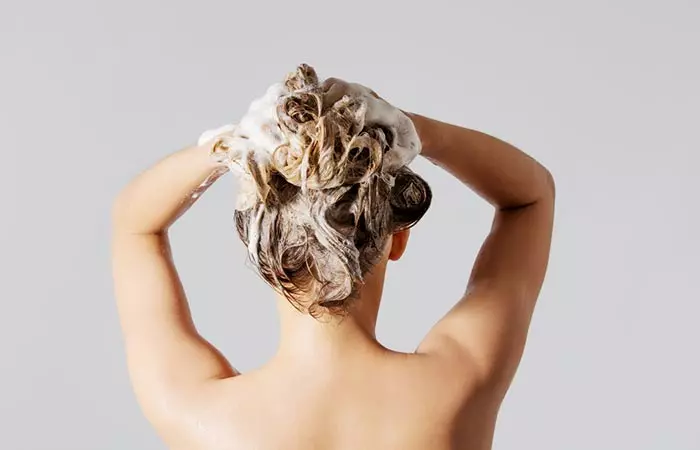
- Use Lukewarm Water: Use lukewarm water to damp your scalp and hair. This process will open your scalp pores to release the stored grime and dirt.
- Make A Rich Lather: Take some shampoo in your palms and add some water to it. Rub your palms to form a rich lather. This action will make your palms moist, thus avoiding friction that may otherwise cause hair breakage.
- Gentle Application: Apply the shampoo to your hair and scalp. Massage gently using your fingertips. Let the shampoo stay for a minute.
- Wash It Off: Wash your hair with warm water. Use your fingers to make circular motions along the scalp to wash any leftover shampoo.
- Use A Leave-In Conditioner: Apply some leave-in conditioner to your hair and its tips. Leave it on for three to five minutes.
Wash With Cold Water: Wash your hair entirely with cold water. This step locks and seals the moisture and makes your hair richer and shinier. - Towel Dry: Use a fresh towel to dry your hair. Do not rub your wet hair harshly. Let it air-dry.
- Use A Wide Toothed Comb: Use a good quality (preferably wooden) comb to untangle your hair.
Castor oil has other benefits besides helping with healthy hair growth. Check the following section.
Other Benefits Of Castor Oil
- It has a powerful laxative effect on the intestinal tract. When taken mouth, it is broken down into the small intestine by the enzyme lipase (lipid or fat-breaking enzyme), releasing ricinoleic acid. The acid increases the motility of the uterus and the intestines (24).
- A castor oil pack relieves constipation by reducing the strain during defecation. It also offers a feeling of complete evacuation after a bowel movement (25).
- When combined with other carrier oils like that of almond, olive, and coconut, the oil works as an excellent emollient. It seals skin hydration and softens and soothes the skin.
- The oil helps in wound healing (26).
- The ricinoleic acid in castor oil has an anti-inflammatory and pain-relieving effect (27).
Though castor oil has several benefits for hair and health, excess use may also lead to some adverse effects. We have listed them below.
Possible Side Effects Of Castor Oil
- It may cause severe hair-felting if not mixed with other carrier oils (23).
- The viscous consistency of castor oil may block the scalp pores and leave hair feeling too oily.
- The oil (the hydrogenated variant) may cause allergic reactions to the scalp or the skin (28).
Note: Always do a patch test on your elbow or back of the ear before applying the oil to your scalp or skin.
The shelf life of a product can also affect its efficacy. So let’s find out if this oil goes bad or not in the following section.
Does Castor Oil Go Bad?
Yes, castor oil does have a shelf life and can go bad after a certain period of time. In general, this oil has an earthy smell that turns foul when it expires. Just like many other oils, castor oil can become rancid when it is exposed to heat, air, or light due to oxidation. If stored properly, it may last up to two years. Regular castor oil has a shelf life of up to a year, while the shelf life of cold-pressed castor oil is 5 years. Make sure to seal the oil container securely and keep it away from light and heat to prevent the oxidation process.
Infographic: Health Benefits Of Castor Oil
Castor oil is packed with many nutrients and beneficial compounds. It enhances the taste of your food and improves your health. This popular cooking oil can help address various health concerns.
Check out the infographic below to learn how castor can improve your health. Illustration: StyleCraze Design Team
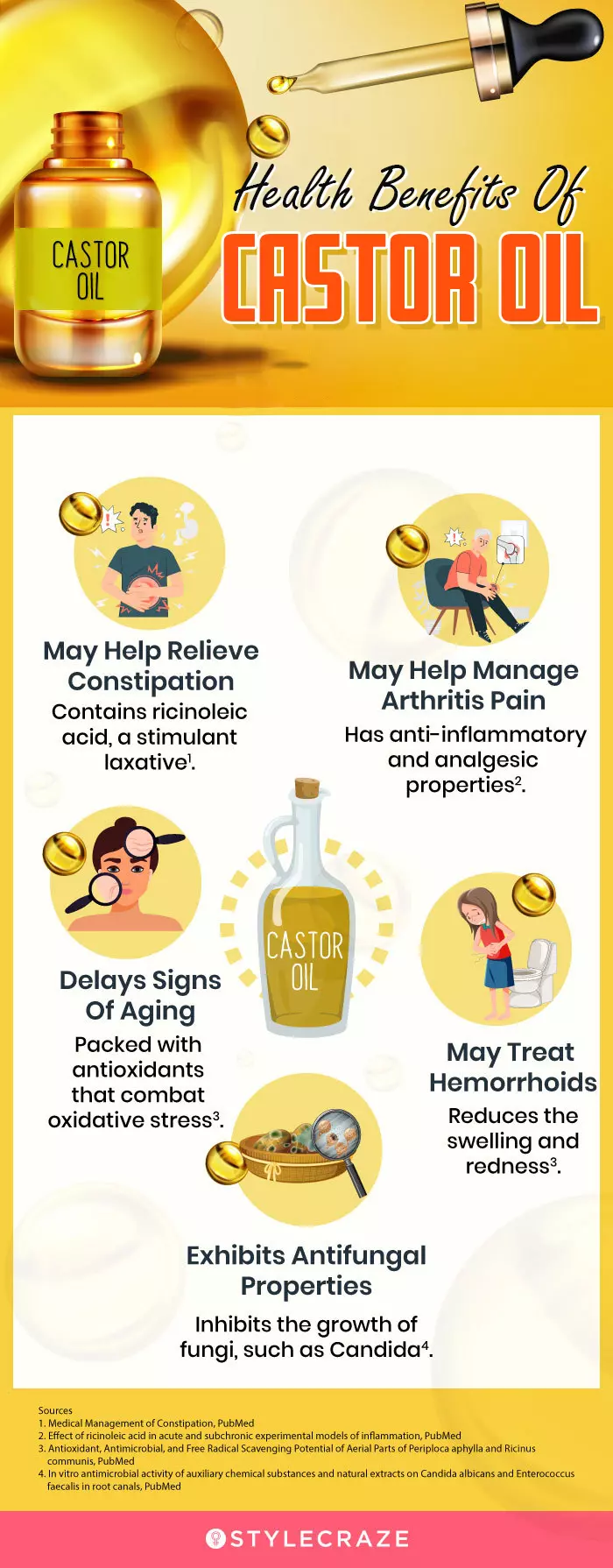
Castor oil for hair growth works effectively by sealing moisture and nourishing the hair. In addition, it stimulates blood circulation and hair growth, reduces scalp inflammation, prevents scalp infections, increases hair luster, strengthens hair roots, and combats hair loss and damage. You can mix castor oil with olive oil, hibiscus petals, coconut oil, onion juice, avocado oil, aloe vera, peppermint oil, rosemary oil, and almond oil for preparing hair masks to boost hair growth. Try regularly including castor oil in your hair care regimen to reap its benefits.
Frequently Asked Questions
Can I apply castor oil every day?
No. As castor oil is a type of heavy oil, it is recommended to apply it once a week to keep your tresses from looking greasy.
Does castor oil help baldness?
Possibly. By boosting hair growth and reducing hair fall, castor oil may aid in the prevention of baldness and encourage hair regrowth.
Do I apply castor oil to wet or dry hair?
Do not apply castor oil to dripping wet hair. As long as you are applying castor oil on clean hair, you can apply it on both damp (50-70% dry) and dry hair. Damp hair is more porous and absorbs oils better. So, if you are looking for a quick and effective treatment for dull and damaged hair, apply castor oil on slightly damp hair. Cold pressed castor oil applies easily on damp hair compared to dry tresses.
Does castor oil grow hair better than olive oil?
Both olive and castor oils penetrate hair strands to moisturize, protect, and nourish them from within. While olive oil may prevent hair loss due to heat and photo damage, castor oil contains ricinoleic acid that may stimulate hair regrowth in those with androgenic alopecia (29).
Can you sleep with castor oil in your hair?
Yes, you can sleep with castor oil in your hair. Make sure to wrap your hair in a towel or wear a shower cap while doing so to avoid staining your pillowcases and bed sheets.
Can castor oil be used on all hair types?
Yes, castor oil can be used on all hair types.But, castor oil is heavy so you might not want to keep it on for more than 30-40 minutes if you have fine hair. Those with coarse, thick, and dry hair can use the oil as an overnight treatment.
Key Takeaways
- Castor oil has been used for centuries to stimulate hair growth, manage hair fall, and repair hair damage.
- You can apply castor oil by itself or blend with other oils and natural ingredients right from the comfort of your home to enhance hair growth, improve moisturization, and more.
- There are three types of castor oils, but the best for your hair is the Jamaican black castor oil that improves blood circulation in the scalp, thereby stimulating hair growth.
- Castor oil’s thick consistency may make it difficult to remove once applied. However, using lukewarm water or a leave-in conditioner can help remove the oil.
Illustration: How To Use Castor Oil For Hair Growth Benefits & Side Effects
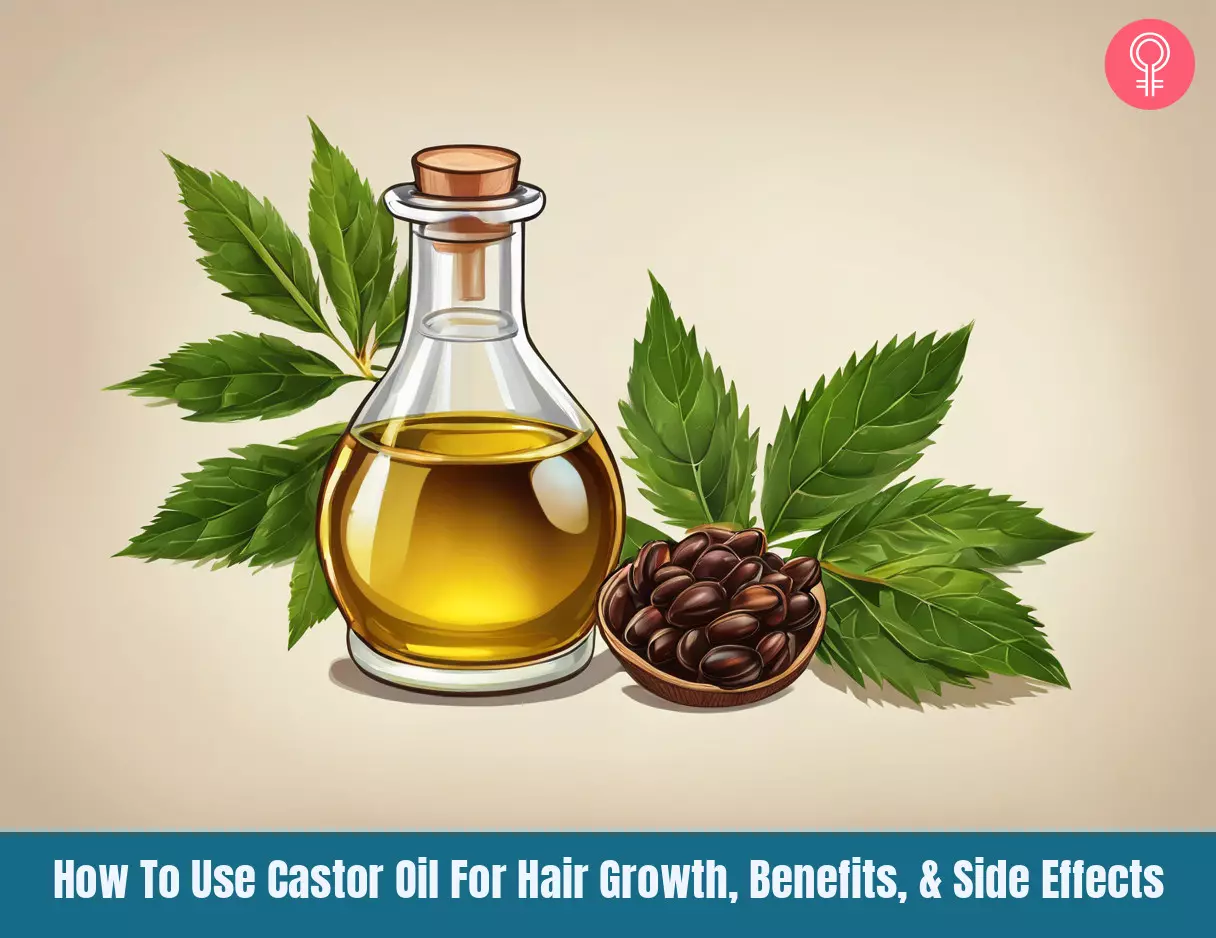
Image: Stable Diffusion/StyleCraze Design Team
Unlock the secrets of luscious hair growth with castor oil. Discover the proper application steps and some tips to maximize its potential for healthy, voluminous locks. Your hair transformation awaits, so watch the video now!
References
Articles on StyleCraze are backed by verified information from peer-reviewed and academic research papers, reputed organizations, research institutions, and medical associations to ensure accuracy and relevance. Read our editorial policy to learn more.
- Ladda, Padma Laxmikant, and Rupali Bhimashankar Kamthane. “Ricinus communis (castor): An overview.” International Journal of Research in Pharmacology & Pharmacotherapeutics2 (2014): 136-44.
https://www.ijrh.org/cgi/viewcontent.cgi?article=1442&context=journal#:~:text=Successful%20treatment%20of%20comorbid%20AD,Kent’s%20Philosophy’s%20second%20prescription. - Vieira, C et al. “Effect of ricinoleic acid in acute and subchronic experimental models of inflammation.” Mediators of inflammation vol. 9,5 (2000): 223-8.
https://www.ncbi.nlm.nih.gov/pmc/articles/PMC1781768/ - Iqbal, Jamshed et al. “Antioxidant, Antimicrobial, and Free Radical Scavenging Potential of Aerial Parts of Periploca aphylla and Ricinus communis.” ISRN pharmacology vol. 2012 (2012): 563267.
https://www.ncbi.nlm.nih.gov/pmc/articles/PMC3418662/ - Sande, Denise et al. “Production of omega 3, 6, and 9 fatty acids from hydrolysis of vegetable oils and animal fat with Colletotrichum gloeosporioideslipase.” Food science and biotechnology vol. 27,2 537-545. 14 Nov. 2017.
https://www.ncbi.nlm.nih.gov/pmc/articles/PMC6049626/ - Munkhbayar, Semchin et al. “Role of Arachidonic Acid in Promoting Hair Growth.” Annals of dermatology vol. 28,1 (2016): 55-64.
https://www.ncbi.nlm.nih.gov/pmc/articles/PMC4737836/ - McMullen, R, and J Jachowicz. “Optical properties of hair: effect of treatments on luster as quantified by image analysis.” Journal of cosmetic science vol. 54,4 (2003): 335-51.
https://pubmed.ncbi.nlm.nih.gov/14528387/ - Zaid, Abdel Naser et al. “Ethnopharmacological survey of home remedies used for treatment of hair and scalp and their methods of preparation in the West Bank-Palestine.” BMC complementary and alternative medicine vol. 17,1 355. 5 Jul. 2017.
https://www.ncbi.nlm.nih.gov/pmc/articles/PMC5499037/ - Gouvinhas, Irene et al. “Critical Review on the Significance of Olive Phytochemicals in Plant Physiology and Human Health.” Molecules (Basel, Switzerland) vol. 22,11 1986. 16 Nov. 2017.
https://www.ncbi.nlm.nih.gov/pmc/articles/PMC6150410/ - Tong, Tao et al. “Topical Application of Oleuropein Induces Anagen Hair Growth in Telogen Mouse Skin.” PloS one vol. 10,6 e0129578. 10 Jun. 2015.
https://www.ncbi.nlm.nih.gov/pmc/articles/PMC4462586/ - Wallace, Taylor C. “Health Effects of Coconut Oil-A Narrative Review of Current Evidence.” Journal of the American College of Nutrition vol. 38,2 (2019): 97-107.
https://pubmed.ncbi.nlm.nih.gov/30395784/ - Nayak, B Satheesha et al. “A Study on Scalp Hair Health and Hair Care Practices among Malaysian Medical Students.” International journal of trichology vol. 9,2 (2017): 58-62.
https://www.ncbi.nlm.nih.gov/pmc/articles/PMC5551307/ - Rele, Aarti S, and R B Mohile. “Effect of mineral oil, sunflower oil, and coconut oil on prevention of hair damage.” Journal of cosmetic science vol. 54,2 (2003): 175-92.
https://pubmed.ncbi.nlm.nih.gov/12715094/ - Beoy, Lim Ai et al. “Effects of tocotrienol supplementation on hair growth in human volunteers.” Tropical life sciences research vol. 21,2 (2010): 91-9.
https://www.ncbi.nlm.nih.gov/pmc/articles/PMC3819075/ - Nishant, Swamy et al. “ Formulation and Evaluation of Herbal Hair Gel Containing Fenugreek Seed Extract For Nourishment and Hair Growth.” International Journal of Scientific Research in Science and Technology July-August-2019; 6(4).
https://ijsrst.com/paper/5979.pdf - Oh, Ji Young et al. “Peppermint Oil Promotes Hair Growth without Toxic Signs.” Toxicological research vol. 30,4 (2014): 297-304. doi:10.5487/TR.2014.30.4.297
https://pubmed.ncbi.nlm.nih.gov/25584150/ - Craighead, Daniel H., and Lacy M. Alexander. “Topical Menthol Increases Cutaneous Blood Flow.” Microvascular Research, Academic Press, 27 Apr. 2016.
https://www.sciencedirect.com/science/article/abs/pii/S0026286216300401?via%3Dihub - Shi, Z et al. Se pu = Chinese journal of chromatography vol. 17,5 (1999): 506-7.
https://pubmed.ncbi.nlm.nih.gov/12552899/ - Suraj, Rejitha et al. “ In vivo Hair Growth Activity pf Prunus dulcis seeds in rats.” Biology and Medicine, 1(4).
https://biolmedonline.com/Articles/vol1_4_34-38.pdf - Sharquie, Khalifa E, and Hala K Al-Obaidi. “Onion juice (Allium cepa L.), a new topical treatment for alopecia areata.” The Journal of dermatology vol. 29,6 (2002): 343-6.
https://pubmed.ncbi.nlm.nih.gov/12126069/ - Flores, Marcos et al. “Avocado Oil: Characteristics, Properties, and Applications.” Molecules (Basel, Switzerland) vol. 24,11 2172. 10 Jun. 2019.
https://www.ncbi.nlm.nih.gov/pmc/articles/PMC6600360/ - Panahi, Yunes et al. “Rosemary oil vs minoxidil 2% for the treatment of androgenetic alopecia: a randomized comparative trial.” Skinmed vol. 13,1 (2015): 15-21.
https://pubmed.ncbi.nlm.nih.gov/25842469/ - Bassino, Eleonora et al. “Protective Role of Nutritional Plants Containing Flavonoids in Hair Follicle Disruption: A Review.” International journal of molecular sciences vol. 21,2 523. 14 Jan. 2020.
https://www.ncbi.nlm.nih.gov/pmc/articles/PMC7013965/ - Maduri, V Ramya et al. “”Castor Oil” – The Culprit of Acute Hair Felting.” International journal of trichology vol. 9,3 (2017): 116-118.
https://www.ncbi.nlm.nih.gov/pmc/articles/PMC5596646/ - Tunaru, Sorin et al. “Castor oil induces laxation and uterus contraction via ricinoleic acid activating prostaglandin EP3 receptors.” Proceedings of the National Academy of Sciences of the United States of America vol. 109,23 (2012): 9179-84.
https://www.ncbi.nlm.nih.gov/pmc/articles/PMC3384204/ - Arslan, Gülşah Gürol, and Ismet Eşer. “An examination of the effect of castor oil packs on constipation in the elderly.” Complementary therapies in clinical practice vol. 17,1 (2011): 58-62.
https://pubmed.ncbi.nlm.nih.gov/21168117/ - Nada, Ahmed A et al. “Bioactive polymeric formulations for wound healing.” Polymers for advanced technologies vol. 29,6 (2018): 1815-1825.
https://www.ncbi.nlm.nih.gov/pmc/articles/PMC6435308/ - Vieira, C et al. “Effect of ricinoleic acid in acute and subchronic experimental models of inflammation.” Mediators of inflammation vol. 9,5 (2000): 223-8.
https://www.ncbi.nlm.nih.gov/pmc/articles/PMC1781768/ - Taghipour, Kathy et al. “Allergic axillary dermatitis due to hydrogenated castor oil in a deodorant.” Contact dermatitis vol. 58,3 (2008): 168-9.
https://pubmed.ncbi.nlm.nih.gov/18279156/ - Hair Oils: Indigenous Knowledge Revisited
https://www.ncbi.nlm.nih.gov/pmc/articles/PMC9231528/
Read full bio of Dr. Vindhya L Veerula
Read full bio of Ramona Sinha
Read full bio of Monomita Chakraborty





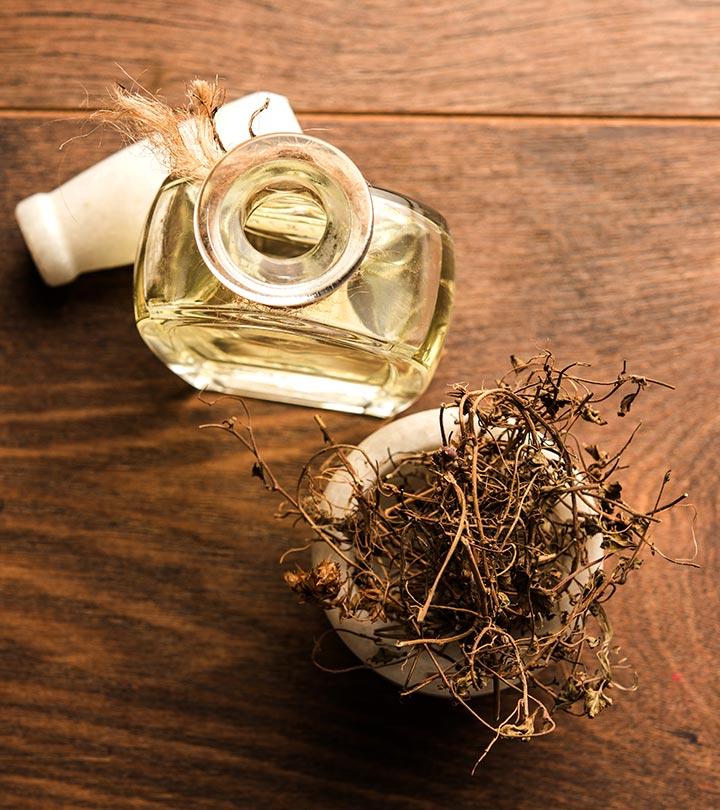


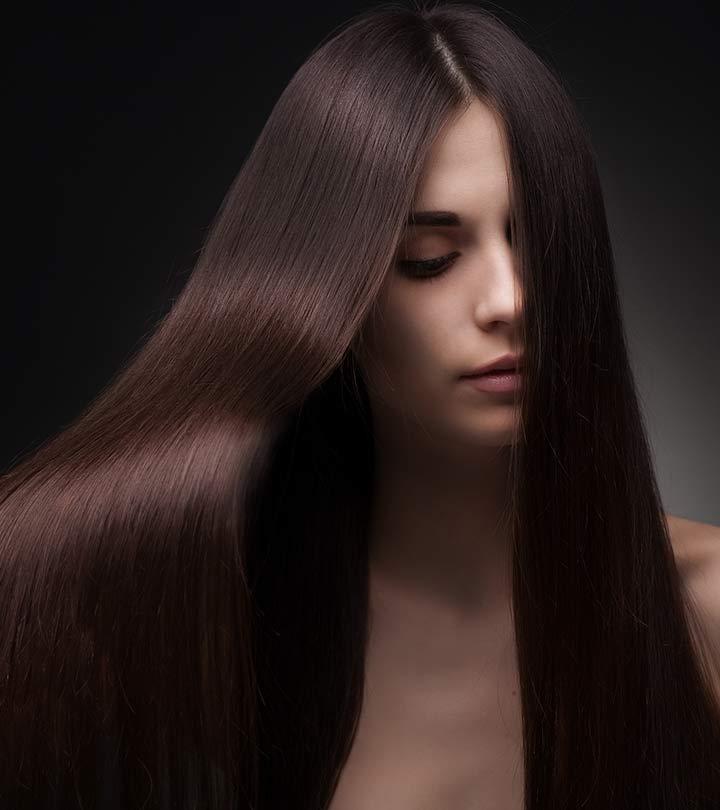
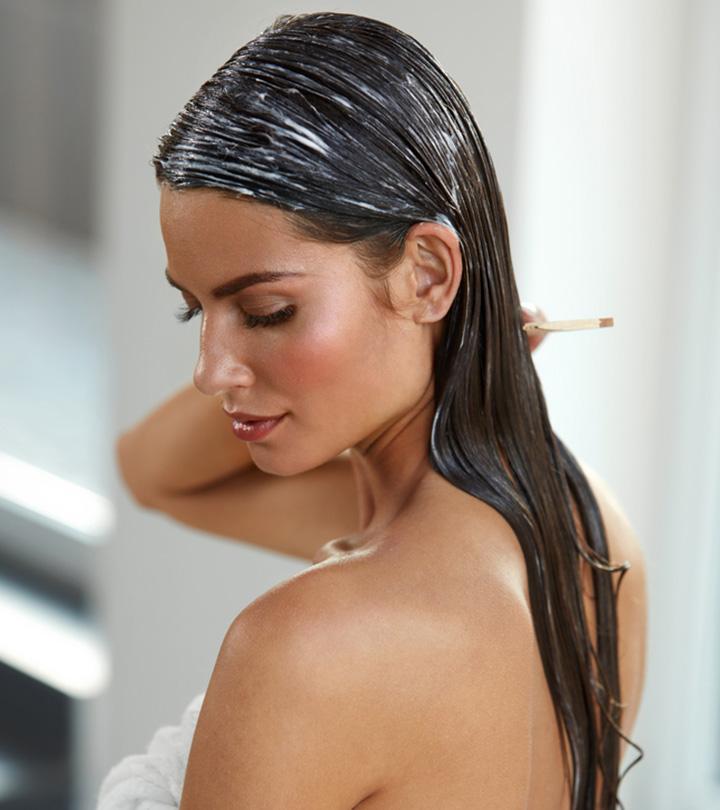


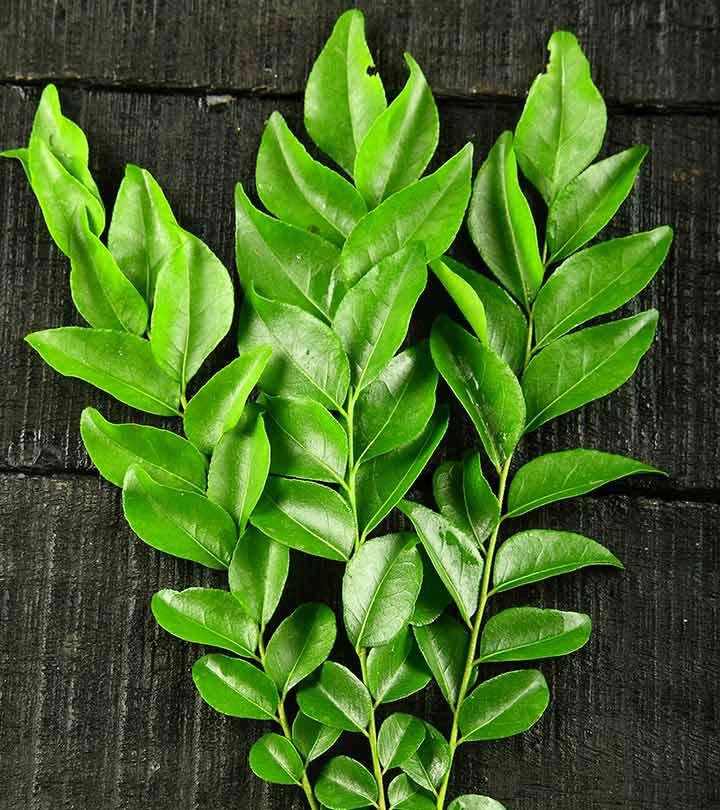
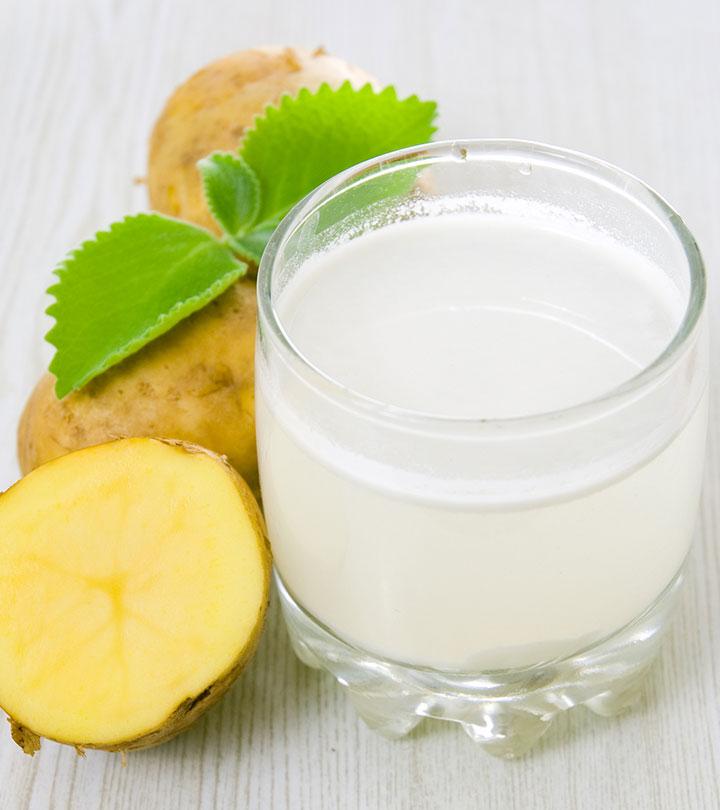



Community Experiences
Join the conversation and become a part of our empowering community! Share your stories, experiences, and insights to connect with other beauty, lifestyle, and health enthusiasts.